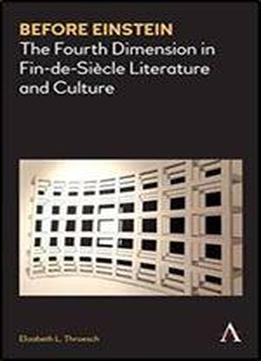
Before Einstein: The Fourth Dimension In Fin-de-siecle Literature And Culture (anthem Nineteenth-century)
by Elizabeth L Throesch /
2017 / English / PDF
2 MB Download
'Before Einstein' examines the discourse of hyperspace philosophy and its position within the network of 'new' ideas at the end of the nineteenth century. Hyperspace philosophy grew out of the concept of a fourth spatial dimension, an idea that became increasingly debated amongst mathematicians, physicists and philosophers during the 1870s and 80s. English mathematician and hyperspace philosopher Charles Howard Hinton was the chief populariser of the fourth dimension in Europe and North America. The influence of his writings, many of which were published as a series under the title of 'Scientific Romances', ranged surprisingly wide.
'Before Einstein' offers, for the first time, an extended examination of Hinton's work and - crucially - the influence of his ideas on contemporary writers and thinkers. Increasingly over the past three decades, critical attention has been given to the relevance of pre-Einsteinian theories of the fourth dimension within the shifting aesthetic and cultural values at the turn of the twentieth century. For the first time in a full-length literary study, 'Before Einstein' addresses the cultural life of the fourth dimension at the turn of the century. 'Before Einstein' begins by tracing the development of spatial theories of the fourth dimension out of the 'new', non-Euclidean geometries of the mid-nineteenth century, and proceeds to analyse Hinton's role as four-dimensional theorist and populariser of hyperspace philosophy. Hinton's 'Scientific Romances' are examined in detail, not simply as documents of t for historians of science and ideas, but for their intrinsic literary value as well. Additionally, 'Before Einstein' captures the work of H. G. Wells, Henry James and William James through the lens of Hinton's writing, identifying what can be described as a four-dimensional literary aesthetic. The book addresses the existing gap in literary studies of the fourth dimension, while also providing scholars of the James brothers and Wells with new ways of approaching their subject matter.











